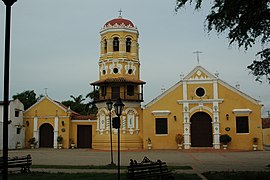Mompos
| Santa Cruz de Mompox | |||
|---|---|---|---|
| Municipality | |||

View of Mompox from the Magdalena River
|
|||
|
|||
 Municipality and town of Mompox in the Bolivar Department. |
|||
| Country |
|
||
| Region | Caribbean Region | ||
| Department | Bolivar Department | ||
| Foundation | 3 May 1537 | ||
| Founded by | Alonso de Heredia | ||
| Government | |||
| • Mayor | Nubia Isabel Quevedo Ángel (2016-2019) |
||
| Area | |||
| • Municipality | 645.37 km2 (249.18 sq mi) | ||
| Elevation | 33 m (108 ft) | ||
| Population (2015) | |||
| • Municipality | 44,124 | ||
| • Density | 68/km2 (180/sq mi) | ||
| • Urban | 25,785 | ||
| Time zone | Colombia Standard Time (UTC-5) | ||
| Website | Official website | ||
 |
|
| UNESCO World Heritage Site | |
|---|---|
| Location |
Bolívar Department, Colombia |
| Coordinates | 9°14′22″N 74°25′30″W / 9.2394°N 74.425°W |
| Area | 645 km2 (6.94×109 sq ft) |
| Criteria | iv, v |
| Reference | 742 |
| Inscription | 1995 (19th Session) |
| Website | santacruzdemompos-bolivar |
|
[]
|
|
Coordinates: 9°14′N 74°25′W / 9.233°N 74.417°W
Mompox or Mompós, officially Santa Cruz de Mompox, is a town and municipality in northern Colombia, in the Bolívar Department, which has preserved its colonial character. Mompox depends upon tourism, fishing and some commerce generated by the local cattle raising. It has about 30,000 inhabitants, and is adjacent to the municipalities of Pinillos and San Fernando.
Simón Bolívar, liberator of much of Spanish South America, said "If to Caracas I owe my life, then to Mompox I owe my glory." Simón Bolívar arrived in Mompox in 1812 and recruited nearly all of the able bodied men, some four hundred, who formed the basis of the army for his victory in Caracas.
Mampo (or Mompoj) was the local indigenous chieftain of the Quimbaya culture, when the Spanish conquistadors arrived, and Mompox means "land of the ruler Mampo". The city was founded on May 3, 1537 by Alonso de Heredia, brother of Pedro de Heredia, as a safe port on the Magdalena. Santa Cruz de Mompox became quite prosperous as a port for the transportation of goods upriver into the interior. A royal mint was established here and the town was famous for its goldsmiths. This prosperity had begun to wane in the nineteenth century, but continued until early in the twentieth century when the river shifted and sediment accumulated on this arm of the river, at which point Magangué became the favored port.
...
Wikipedia



